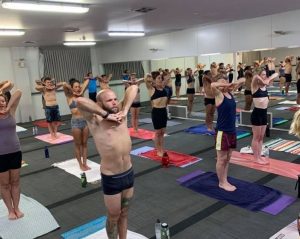It’s pretty normal when you first come along to Bikram yoga to wonder why we do this breathing thing at the start of every class. When studio founder Jodie started Bikram yoga in 1997 she thought Pranayama was boring, a waste of time and just wanted to get on with the “real” yoga, the one that got her heart rate up!
Around 10% of a Bikram class is breathing exercises. They are a key component of a traditional authentic yoga practice. So let’s have a dig into why.

So what does Pranayama do?
It’s not unusual to start a Bikram class feeling a little nervous, or perhaps the day’s been a bit crazy and your mind is all over the place. It is essential to prepare your mind for class and this is where pranayama deep breathing comes in.
When we do Pranayama we slow our breathing down to just 5 breaths a minute, rather than around 15. We are actually breathing less. Slow, deep breathing signals to the parasympathetic nervous system (PSNS) to kick in more strongly to calm down the body and the mind. The PSNS is the division of your nervous system, also known as the “rest and digest” part.
So Pranayama does the important job of shifting gear and getting you mentally prepared for your yoga practice.
How does it prepare you?
Yoga from the outside can look a lot like a stretch class, and without breath and mind awareness, it is just that.
Energetically, the guiding principle behind Pranayama is that we all hold physical or emotional blocks in our bodies which inhibit the flow of breath and of prana – life energy. A regular Pranayama practice can help improve the flow, lessen the blockages.
When the mind is still and quieter and the breath flows, physical postures will come with more ease because they are not accompanied by the busy monkey mind and subliminal stressors. That’s what we’re aiming for anyway! When the mind is fighting, the body is fighting.
A regular Pranayama practice can stimulate the parasympathetic system, countering the overstimulation our bodies go through during the Fight or Flight response of the sympathetic nervous system.
Pranayama breath may:
• Decrease stress
• Improve sleep quality
• Increase mindfulness
• Reduce high BP
• Improve lung function
• Enhance cognitive performance
Plus you can use Pranayama at any time of the day. Before a big meeting, feeling a little the worse for wear, nervous about a job interview, lacking sleep, about to sit an exam. My daughter stood and did 2 sets of pranayama in Wynyard Park Sydney before a flute exam when she was 15 years old!
So don’t miss Pranayama Deep Breathing!
